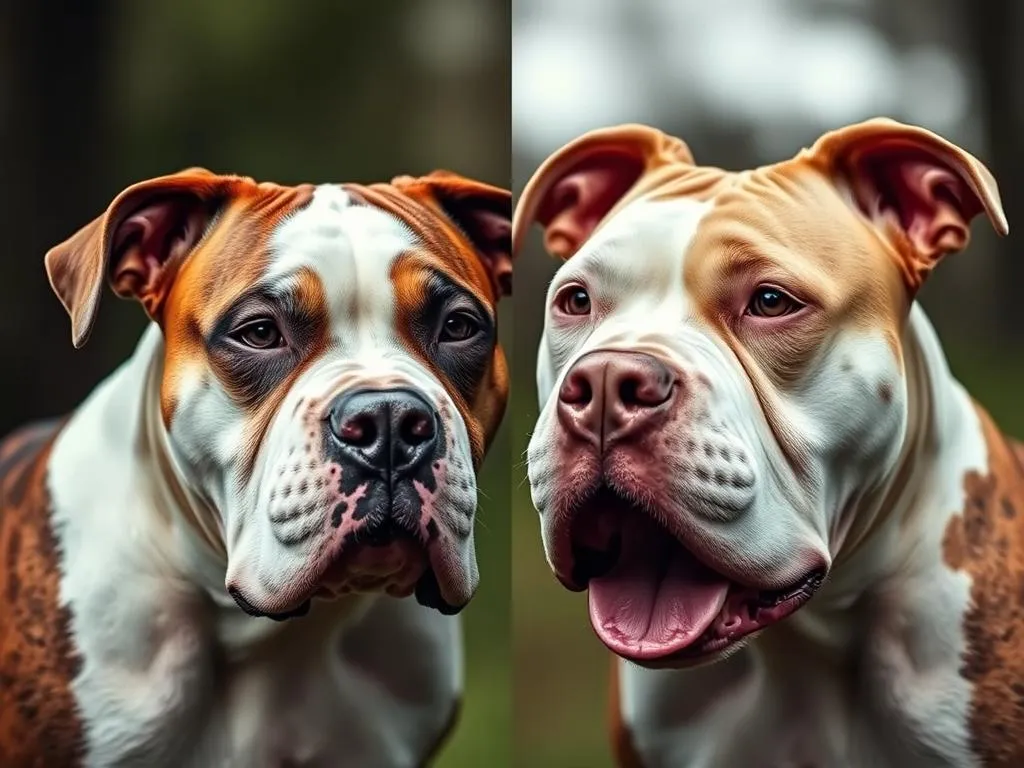
Introduction
Understanding the differences and similarities between American Bulldogs and Pitbulls is essential for potential dog owners. Both breeds have unique characteristics that can greatly influence the ownership experience, training methods, and suitability for families.
Dog breeds can significantly impact an owner’s lifestyle, preferences, and family dynamics. Knowing the traits of each breed can help prospective owners make more informed choices. This article focuses on the comparison of American Bulldog vs Pitbull, ensuring that you gain a deeper understanding of these two popular breeds.
Overview of American Bulldogs
History and Origin
The American Bulldog traces its roots back to ancient breeds, particularly the English Bulldog. Initially bred for utility purposes, American Bulldogs were used for farm work, including catching livestock and guarding properties. Their strong build and tenacity made them ideal for these tasks. Over time, the breed evolved, with selective breeding emphasizing strength and agility, leading to the robust dogs we see today.
Physical Characteristics
American Bulldogs are known for their impressive size and muscular build. Adult males typically weigh between 80 to 120 pounds, while females range from 60 to 100 pounds. They stand about 20 to 28 inches tall at the shoulder. Their coat is short, smooth, and can come in various colors, including white, brindle, and fawn, often with patches.
Distinguishing features include a broad head, strong jaws, and a powerful neck, which contribute to their overall imposing appearance. Their muscular physique is complemented by a sturdy stance, making them both agile and powerful.
Temperament and Behavior
American Bulldogs are often described as loyal, confident, and protective. They tend to be affectionate with their families, making them suitable companions for children. However, they require proper socialization and training from a young age to ensure they develop into well-adjusted adults.
These dogs are energetic and need regular exercise to keep them physically and mentally stimulated. They thrive in active households and enjoy participating in various activities, from fetch to agility training.
Health Considerations
Like all breeds, American Bulldogs are prone to certain health issues. Common concerns include hip dysplasia, skin allergies, and certain types of cancers. Their lifespan averages between 10 to 15 years, and proper care, including regular vet check-ups and a balanced diet, can contribute to a longer, healthier life.
Overview of Pitbulls
History and Origin
The term “Pitbull” is often used to describe several breeds, including the American Pit Bull Terrier and the American Staffordshire Terrier. These breeds share a common ancestry with bulldogs and terriers, originally bred for bull-baiting and farm work. Over the years, they transitioned into companion animals, showcasing their intelligence and loyalty.
Physical Characteristics
Pitbulls vary in size and weight depending on the specific breed. Generally, they weigh between 30 to 85 pounds and stand about 17 to 21 inches tall. Their coat is short and smooth, available in various colors, including black, blue, and brindle.
Pitbulls are characterized by their muscular frame, strong jaws, and distinctively broad heads. They exhibit a stocky build, which contributes to their powerful appearance.
Temperament and Behavior
Pitbulls are known for their friendly and affectionate nature. They form strong bonds with their families and are often great with children. These dogs are intelligent and eager to please, which makes them trainable. However, they require consistent training and socialization to curb any aggressive tendencies and ensure they grow up to be well-rounded pets.
Their energy levels are high, necessitating regular exercise to keep them happy and healthy. They thrive in active environments where they can engage in play and physical activities.
Health Considerations
Pitbulls have their share of health considerations, including hip dysplasia, allergies, and heart issues. Their average lifespan ranges from 12 to 16 years. Regular veterinary care, a nutritious diet, and an active lifestyle can help mitigate many of these health concerns.
American Bulldog vs Pitbull: Key Comparisons
Physical Differences
When comparing American Bulldogs vs Pitbulls, physical size is one of the most noticeable differences. American Bulldogs tend to be larger and heavier than most Pitbulls. While American Bulldogs can weigh up to 120 pounds, many Pitbulls typically weigh between 30 to 85 pounds.
In terms of coat and color variations, both breeds share similarities with short, smooth coats, but American Bulldogs often have more diverse color patterns.
Temperament and Behavior Differences
While both breeds exhibit loyalty and affection towards their families, their temperament can vary. American Bulldogs are known for their protective nature, whereas Pitbulls are often more social and outgoing. Training responsiveness also differs; Pitbulls tend to be more eager to please, while American Bulldogs may display a more independent streak.
Health and Care Differences
Health issues can vary between the two breeds. While both are prone to hip dysplasia and skin problems, the specific health concerns may differ. For example, Pitbulls may be more susceptible to heart-related issues, while American Bulldogs often face more skin allergies.
Dietary needs also differ slightly; American Bulldogs may require a higher protein diet to maintain their muscular physique, while Pitbulls, due to their smaller size, may have different nutritional requirements.
Legal and Social Perceptions
Both breeds face stigma and breed-specific legislation in various jurisdictions. American Bulldogs are often viewed as less aggressive compared to Pitbulls, but both breeds can be subject to restrictions in certain areas. Public perception can vary significantly, with Pitbulls often facing negative stereotypes as aggressive dogs.
Which Breed is Right for You?
Lifestyle Considerations
When choosing between American Bulldogs and Pitbulls, consider your lifestyle and living situation. If you’re active and have space for a larger dog, an American Bulldog may be suitable. Conversely, if you’re looking for a smaller, agile dog that still has high energy levels, a Pitbull might be the better choice.
Family dynamics also play a crucial role. Both breeds can be excellent with children, but individual temperament should be considered.
Training and Socialization Requirements
Both breeds require training and socialization from an early age. Consistency and positive reinforcement methods work best. Engaging in obedience classes can be beneficial for both American Bulldogs and Pitbulls, helping them develop good manners and social skills.
Adoption and Rescue Options
Adopting from shelters can be a rewarding experience. Many American Bulldogs and Pitbulls are in need of homes. Local rescues often have resources and assistance for finding the right fit for your family.
Conclusion
In summary, when comparing American Bulldogs vs Pitbulls, it is clear that both breeds offer unique characteristics and qualities that can make them excellent companions. Understanding their differences in history, physical traits, temperament, and health can help potential owners make informed decisions.
Ultimately, individual temperament and suitability for your lifestyle should be the guiding factors in choosing between these two breeds.
FAQs
Are American Bulldogs and Pitbulls the same?
No, while they share some similarities, they are distinct breeds with different histories and characteristics.
Which breed is better for families?
Both breeds can be great for families, but individual temperament and socialization are crucial factors.
What are the training needs for American Bulldogs vs. Pitbulls?
Both breeds require consistent training and early socialization. Positive reinforcement methods are effective for both.
How do health issues compare between the two breeds?
Both breeds can face similar health issues, but specific concerns may vary. Regular vet check-ups are essential for both.
Is it safe to own either breed in urban areas?
Yes, both breeds can adapt to urban living, provided they receive enough exercise and socialization.
By understanding these key aspects, prospective owners can make educated choices that align with their lifestyles and preferences.








